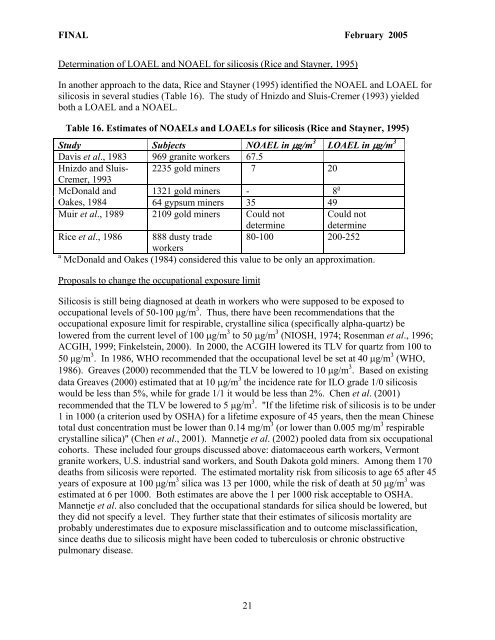Silica (crystalline, respirable) - OEHHA
Silica (crystalline, respirable) - OEHHA
Silica (crystalline, respirable) - OEHHA
You also want an ePaper? Increase the reach of your titles
YUMPU automatically turns print PDFs into web optimized ePapers that Google loves.
FINAL February 2005<br />
Determination of LOAEL and NOAEL for silicosis (Rice and Stayner, 1995)<br />
In another approach to the data, Rice and Stayner (1995) identified the NOAEL and LOAEL for<br />
silicosis in several studies (Table 16). The study of Hnizdo and Sluis-Cremer (1993) yielded<br />
both a LOAEL and a NOAEL.<br />
Table 16. Estimates of NOAELs and LOAELs for silicosis (Rice and Stayner, 1995)<br />
Study Subjects NOAEL in µg/m 3 LOAEL in µg/m 3<br />
Davis et al., 1983 969 granite workers 67.5<br />
Hnizdo and Sluis-<br />
Cremer, 1993<br />
2235 gold miners 7 20<br />
1321 gold miners - 8 a<br />
McDonald and<br />
Oakes, 1984 64 gypsum miners 35 49<br />
Muir et al., 1989 2109 gold miners Could not Could not<br />
determine determine<br />
Rice et al., 1986 888 dusty trade<br />
workers<br />
80-100 200-252<br />
a<br />
McDonald and Oakes (1984) considered this value to be only an approximation.<br />
Proposals to change the occupational exposure limit<br />
Silicosis is still being diagnosed at death in workers who were supposed to be exposed to<br />
occupational levels of 50-100 µg/m 3 . Thus, there have been recommendations that the<br />
occupational exposure limit for <strong>respirable</strong>, <strong>crystalline</strong> silica (specifically alpha-quartz) be<br />
lowered from the current level of 100 µg/m 3 to 50 µg/m 3 (NIOSH, 1974; Rosenman et al., 1996;<br />
ACGIH, 1999; Finkelstein, 2000). In 2000, the ACGIH lowered its TLV for quartz from 100 to<br />
50 µg/m 3 . In 1986, WHO recommended that the occupational level be set at 40 µg/m 3 (WHO,<br />
1986). Greaves (2000) recommended that the TLV be lowered to 10 µg/m 3 . Based on existing<br />
data Greaves (2000) estimated that at 10 µg/m 3 the incidence rate for ILO grade 1/0 silicosis<br />
would be less than 5%, while for grade 1/1 it would be less than 2%. Chen et al. (2001)<br />
recommended that the TLV be lowered to 5 µg/m 3 . "If the lifetime risk of silicosis is to be under<br />
1 in 1000 (a criterion used by OSHA) for a lifetime exposure of 45 years, then the mean Chinese<br />
total dust concentration must be lower than 0.14 mg/m 3 (or lower than 0.005 mg/m 3 <strong>respirable</strong><br />
<strong>crystalline</strong> silica)" (Chen et al., 2001). Mannetje et al. (2002) pooled data from six occupational<br />
cohorts. These included four groups discussed above: diatomaceous earth workers, Vermont<br />
granite workers, U.S. industrial sand workers, and South Dakota gold miners. Among them 170<br />
deaths from silicosis were reported. The estimated mortality risk from silicosis to age 65 after 45<br />
years of exposure at 100 µg/m 3 silica was 13 per 1000, while the risk of death at 50 µg/m 3 was<br />
estimated at 6 per 1000. Both estimates are above the 1 per 1000 risk acceptable to OSHA.<br />
Mannetje et al. also concluded that the occupational standards for silica should be lowered, but<br />
they did not specify a level. They further state that their estimates of silicosis mortality are<br />
probably underestimates due to exposure misclassification and to outcome misclassification,<br />
since deaths due to silicosis might have been coded to tuberculosis or chronic obstructive<br />
pulmonary disease.<br />
21















